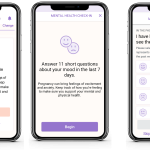As Mental Health Awareness Month draws to a close, we spotlight two mental health conditions that can affect children and young adults: bipolar disorder and pediatric anxiety disorder.
Bipolar disorder, previously called manic depression, was originally thought to be rare in young people but experts now believe it first presents itself in childhood or early adolescence. It is marked by two types of episodes: manic and depressive.
Manic episodes are periods of extremely happy, or elevated mood. Children with bipolar disorder may experience manic episodes combined with symptoms such as wild or reckless behavior, little need for sleep, continuous high level of energy, or extreme overconfidence. On the other side of the spectrum, depressive episodes are marked by periods of sad, low or irritable mood. This can be coupled with symptoms such as not finding pleasure in normally enjoyable things, low energy, feelings of guilt or worthlessness, or withdraw from friends and family. It is possible for children with bipolar disorder to switch back and forth between episodes of mania and depression, even within the course of just one day.
Early detection of bipolar disorder in children can be challenging because it is often mistaken for other psychiatric disorders. Children who have bipolar disorder may also deal with attention deficit hyperactivity disorder (ADHD), oppositional defiant disorder (persistent angry and tantrum-like behavior) or anxiety disorders.
The most common treatment for bipolar disorder in children is medication, most likely coupled with psychotherapy, education and maintaining a stable sleep-wake schedule. It may take trials of different medications or combinations of those medications to realize the best response, so talk to your doctor to learn more about what is best.
Pediatric anxiety disorder is one of the most common psychiatric disorders in children and adolescents, with prevalence rates between 10 and 20 percent.While anxiety can sometimes be helpful or adaptive (and is common for everyone, especially children and adolescents), problems arise when anxiety interferes with a child’s ability to complete everyday tasks. Excessive anxiety includes severe distress when participating in normal events such as social activities with friends and attending school.
There are different types of pediatric anxiety disorders, each dependent on the situation triggering the anxiety. Children with social phobias for example are worried about being embarrassed or judged, leading to a significant fear of social settings. Other kinds of anxiety include separation anxiety disorder and generalized anxiety disorder, where kids experience excessive worry about a wide range of topics such as school, friends, family, health and past or future events.
Some children and adolescents may experience mild anxiety, rarely interfering with their everyday lives. Education and support may be enough to combat this limited anxiety, while those with moderate anxiety may begin treatment with psychotherapy, medication or both combined. Cognitive behavioral therapy (CBT) is a common form of psychotherapy. CBT for pediatric anxiety disorders can include education, self-monitoring, progressive muscle relaxation, mediation, identification of maladaptive thoughts and teaching of coping focused thinking. CBT allows for children with anxiety disorders to be gradually exposed to feared situations. Selective serotonin reuptake inhibitors are the primary medication for pediatric anxiety disorders, but talk to your doctor to discuss what is best for your family.
Here at UPMC, resources include the Child and Adolescent Inpatient Unit for Bipolar Disorders at Western Psychiatric Institute and Clinic (WPIC), and the The Services for Teens at Risk (STAR) Anxiety Program at WPIC, which offers comprehensive treatment for youth ages 7 to 17 with generalized anxiety disorder, social phobia, separation anxiety disorder or panic disorder.









